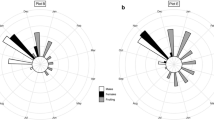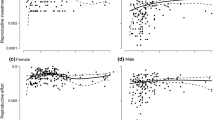Abstract
Early seed production by non-native plants may be important to their successful establishment and spread. Understanding the mechanisms underlying age- or size-biased seed production in introduced plants may also identify factors that contribute to propagule pressure and their success as invaders. Here, we asked whether differences in male and female reproductive allocation among individuals of the invasive woody plant species Triadica sebifera (L.) Small (Euphorbiaceae), a monoecious prolific seed producer, were consistent with a life-history trade-off involving sex allocation. We also asked if the quality of seeds produced by trees of different size differed in terms of seed size and germinability. We found no evidence that biomass allocation to either male or female function was related to plant size. Trees varied in ratio of female:male investment from 0.6 to 15.8, but investment ratio was also unrelated to plant size. We also found no relationship between plant size and seed size or mean germination time, and a weak negative relationship between percent seed germination and plant size. Overall, the results do not support the idea that patterns of reproductive sex allocation are the result of a life-history trade-off and are instead most consistent with local resource tracking by individual trees.



Similar content being viewed by others
References
Aarssen LW (2008) Death without sex—the ‘problem of the small’ and selection for reproductive economy in flowering plants. Evol Ecol 22:279–298
Bell G, Koufopanou V (1986) The cost of reproduction. Oxf Surv Evol Biol 3:83–131
Bonser SP, Aarssen LW (1996) Meristem allocation: a new classification theory for adaptive strategies in herbaceous plants. Oikos 77:347–352
Burd M, Allen TFH (1988) Sexual allocation strategy in wind-pollinated plants. Evolution 42:403–407
Burke MJ, Grime J (1996) An experimental study of plant community invasibility. Ecology 77:776–790
Burns JH, Pardini EA, Schutzenhofer MR, Chung YA, Seidler KJ, Knight TM (2013) Greater sexual reproduction contributes to differences in demography of invasive plants and their noninvasive relatives. Ecology 94:995–1004
Campbell DR (2000) Experimental tests of sex-allocation theory in plants. Trends Ecol Evol 15:227–232
Charnov EL (1982) The theory of sex allocation. Princeton University Press, Princeton
Charnov EL, Bull J (1977) When is sex environmentally determined? Nature 266:828–830
de Jong TJ, Klinkhamer PGL (2005) Evolutionary ecology of plant reproductive strategies. Cambridge University Press, Cambridge
DeWalt SJ, Siemann E, Rogers WE (2011) Geographic distribution of genetic variation among native and introduced populations of Chinese tallow tree, Triadica sebifera (Euphorbiaceae). Am J Bot 98(7):1128–1138
Dorken ME, Pannell JR (2008) Density-dependent regulation of the sex ratio in an annual plant. Am Nat 171:828–830
Fox J (1993) Size and sex allocation in monoecious woody plants. Oecology 94:110–113
Freeman DC, Klikoff LG, Harper KT (1976) Differential resource utilization by the sexes of dioecious plants. Science 193:597–599
Freeman DC, Harper KT, Charnov EL (1980) Sex change in plants: old and new observations and new hypotheses. Oecology 47:222–232
Freeman DC, McArthur ED, Harper KT, Blauer AC (1981) Influence of environment on the floral sex ratio of monoecious plants. Evolution 35:194–197
Gabler CA, Siemann E (2013) Timing of favorable conditions, competition, and fertility interact to govern recruitment of invasive Chinese tallow tree in stressful environments. PLoS ONE 8:e71446
Godfrey RK, Wooten JW (1981) Aquatic and wetland plants of the southeastern United States. University of Georgia Press, Athens, p 933
Huang W, Carrillo J, Ding J, Siemann E (2012) Invader partitions ecological and evolutionary responses to above- and belowground herbivory. Ecology 93:2343–2352
Iwasa Y (1991) Sex change evolution and cost of reproduction. Behav Ecol 2:56–68
Klinkhamer PGL, de Jong T, de Bruyn G (1989) Plant size and pollinator visitation in Cynoglossum officinale. Oikos 51:201–204
Klinkhamer PGL, de Jong T, Metz H (1997) Sex and size in cosexual plants. Trends Ecol Evol 12:260–265
Knops J, Koenig W (2012) Sex Allocation in California Oaks: trade-offs or resource tracking? PLoS ONE 7:e43492
Kolar CS, Lodge D (2001) Progress in invasion biology: predicting invaders. Trends Ecol Evol 16:199–204
Lloyd DG, Bawa KS (1984) Modification of the gender of seed plants in varying conditions. Evol Biol 17:255–338
Lobo JA, Ramos DDL, Braga AC (2016) Visitation rate of pollinators and nectar robbers to the flowers and inflorescences of Tabebuia aurea (Bignoniaceae): effects of floral display size and habitat fragmentation. Biol J Linn Soc 181:667–681
McKone MJ (1990) Characteristics of pollen production in a population of New Zealand snow-tussock grass (Chionochloa pallens Zotov). New Phytol 116:555–562
Meyer R (2011) Triadica sebifera. In: Fire Effects Information System. US Department of Agriculture, Forest Service, Rocky Mountain Research Station, Fire Sciences Laboratory, https://www.fs.fed.us/database/feis/. Accessed 25 January 2017
Ne’eman G, Goubitz S, Werger M, Shmida A (2011) Relationships between tree size, crown shape, gender segregation, and sex allocation in Pinus halepensis, a Mediterranean pine tree. Ann Bot 108:197–206
Obeso J (2002) The cost of reproduction in plants. New Phytol 155:321–348
R Core Team (2017) R: A language and environment for statistical computing. R Foundation for Statistical Computing, Vienna, Austria. https://www.R-project.org/.
Radford AE, Ahles HE, Bell CR (1968) Manual of the vascular flora of the Carolinas. The University of North Carolina Press, Chapel Hill, p 1183
Rejmanek M, Richardson DM (1996) What attributes make some plant species more invasive? Ecology 77:1655–1661
Renne IJ, Gauthreaux SA, Gresham CA (2000) Seed dispersal of the Chinese tallow tree (Sapium sebiferum (L.) Roxb.) by birds in coastal South Carolina. Am Midl Nat 144:202–215
Reznick D (1985) Costs of reproduction: an evaluation of the empirical evidence. Oikos 44:257–267
Scheld HW, Cowles JR, Engler CR, Kleiman R, Shultz EB Jr (1984) Seeds of Chinese tallow tree as a source of chemicals and fuels. In: Shultz EB Jr, Morgan RP (eds) Fuels and chemicals from oil seeds: Technology and policy options: Symposium proceedings; 1982 January 3-8; Washington, DC. AAAS Selected Symposia Series 91. Westview Press. Boulder, Colorado, pp 97-111
Siemann E, Rogers WE (2003b) Herbivory, disease, and recruitment limitation, and success of alien and native tree species. Ecology 84:1489–1505
Silvertown J, Dodd M (1999) The demographic cost of reproduction and its consequences in balsam fir (Abies balsamea). Am Nat 154:321–332
Solbrig OT (1981) Studies on the population biology of the genus Viola. II. The effect of plant size on fitness in Viola sororia. Evolution 35:1080–1093
Stearns S (1992) The evolution of life histories. Oxford University Press, New York
Thomas SC (2011) Age-related changes in tree growth and functional biology: the role of reproduction. In: Meinzer FC, Lachenbruch B, Dawson TE (eds) Size- and age-related changes in tree structure and function. Springer, Dordrecht, pp 33–64
Tian N, Fan Z, Matney TG, Schultz EB (2017) Growth and stem profiles of invasive Triadica sebifera in the Mississippi Coast of the United States. For Sci 63(6):569–576
Tracey AJ, Aarssen LW (2011) Competition and body size in plants: the between-species trade- off for maximum potential versus minimum reproductive threshold size. J Plant Ecol 4(3):115–122
Vega-Frutis R, Marcías-Ordóñez R, Guevara R, Fromhage L (2014) Sex change in plants and animals: a unified perspective. J Evol Biol 27:667–675
Warton DI, Hui FKC (2011) The arcsine is asinine: the analysis of proportions in ecology. Ecology 92:3–10
Web Soil Survey (2016) Soil Survey Staff, Natural Resources Conservation Service, United States Department of Agriculture. https://websoilsurvey.sc.egov.usda.gov/. Accessed 18 Dec 2016
Weiner J, Rosenmeier L, Massoni ES, Vera JN, Hernández Plaza E, Sebastià MT (2009) Is reproductive allocation in Senecio vulgaris plastic? Botany 87:475–481
West SA (2009) Sex Allocation. Princeton University Press, Princeton
Wharton DI, Duursma RA, Falster DS, Taskinen S (2012) smatr 3—an R package for estimation and inference about allometric lines. Methods Ecol Evol 3(2):257–259
Willson MF, Price PW (1977) Evolution of inflorescence size in Asclepias (Asclepiadaceae). Evolution 31:4956–5511
Yang Q, Li B, Siemann E (2014) Positive and negative biotic interactions and invasive Triadica sebifera tolerance to salinity: a cross-continent comparative study. Oikos 124:216–224
Zhang L, Zhang Y, Wang H, Zou J, Siemann E (2013) Chinese tallow trees (Triadica sebifera) from the invasive range outperform those from the native range with an active soil community or phosphorus fertilization. PLoS ONE 8:e74233
Zou J, Rogers WE, DeWalt SJ, Siemann E (2006) The effect of Chinese tallow tree (Sapium sebiferum) ecotype on soil-plant system carbon and nitrogen processes. Oecol 150:272–281
Acknowledgements
We gratefully acknowledge Dawn Dawson and Jackie Bee Investments, LLC (Boutte), Katie Brasted at The Woodlands Conservancy (Belle Chasse), and Dominick Impastato (Kenner) for allowing land access to the field study sites used for this research. We also thank Brett Babin for his dedicated field assistance during the entire course of this study.
Author information
Authors and Affiliations
Corresponding author
Additional information
Communicated by Claus Holzapfel.
Publisher's Note
Springer Nature remains neutral with regard to jurisdictional claims in published maps and institutional affiliations.
Rights and permissions
About this article
Cite this article
Babin, C.H., Howard, J.J. Does plant allometry predict biased sex allocation in Triadica sebifera (L.) small (Euphorbiaceae)?. Plant Ecol 220, 529–539 (2019). https://doi.org/10.1007/s11258-019-00933-0
Received:
Accepted:
Published:
Issue Date:
DOI: https://doi.org/10.1007/s11258-019-00933-0




